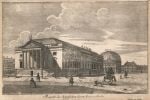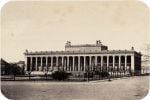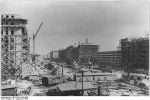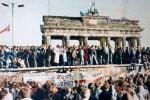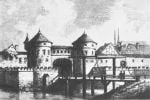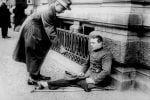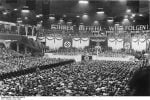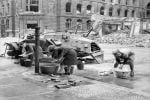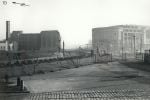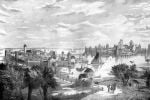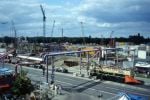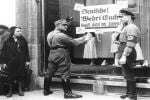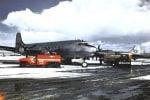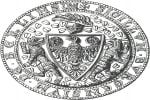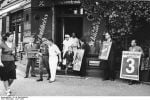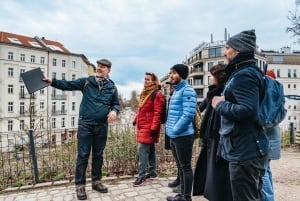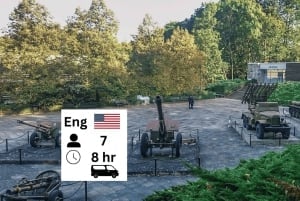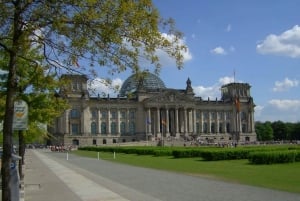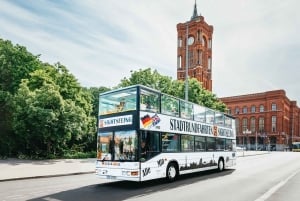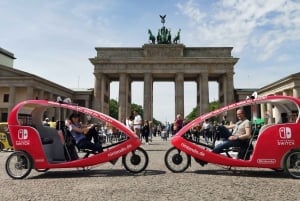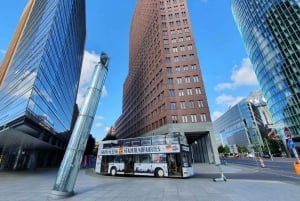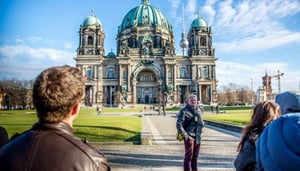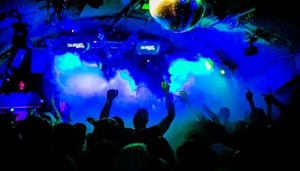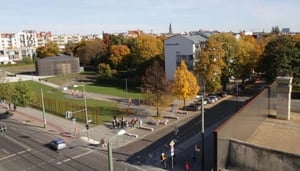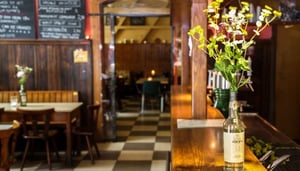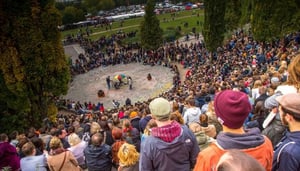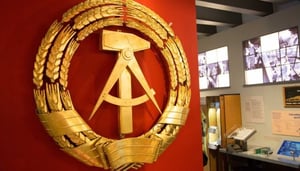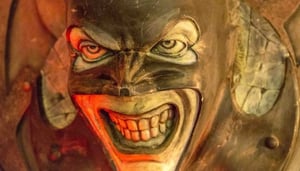Berlin History
Compared to many other major cities around the world and even throughout Germany, Berlin is a relatively young city with initial records of the town of Berlin dating from 1237. Berlin’s history is incredibly varied, from the height of prosperity as the capital of Prussia, to the utter devastation of World War Two. For 45 years it existed as a city divided by the Berlin Wall until its fall in 1989. In the twenty something years since reunification Berlin has forged a new identity and re-emerged out from under the iron curtain as a vibrant, tolerant, and exciting European capital.
Beginnings
Although the marshy area where Berlin now stands has been inhabited since the Bronze Age, the area was first settled by slavs sometime in the 8th or 9th Century.
The initial town of Berlin, built by the Slavs, was located on the eastern bank of the river Spree, roughly where the Nikolaiviertel, the oldest section of Berlin, now stands. In the 12th Century, German settlers reached the area and founded a town name Cölln on the island now known as Museumsinsel.
In the 12 Century the area came under the rule of the Margravate of Brandenburg, founded by Albert the Bear in 1157 and to this day the emblem of the Bear appears on the Berlin coat of arms.
IMAGE: 12C Berlin and Cölln. Woodcarving by F. Wittig 1882
13th – 14th Century
The two settlements slowly grew in size and eventually merged and became known as Berlin-Cölln. By the end of the 14th Century there were roughly 8000 inhabitants living in the town.
IMAGE: Seal of Berlin 1280
15th – 17th Century
In 1415, Frederick I, the new Margrave of Brandenburg became the first member of the Hohenzollern family to rule Berlin. The Hohenzollerns ruled Berlin exclusively until their defeat in the First World War in 1918.
The first Berliner Stadtschloss (City Palace) was completed on the shore of the river Spree in 1451 and Berlin was designated as the royal residence of the Brandenburg electors.
In 1539, Berlin converted to Lutheranism, and the following year Elector Joachim II introduced the Protestant Reformation, secularising church possessions, and allowing him to fund construction of the Kurfürstendamm, an avenue that led from his hunting castle to the Berliner Stadtschloss.
The 16th Century was not a great time to be a resident of Berlin. In 1576, the plague wiped out around 4000 people, reducing the population to 12,000 residents. As if that wasn’t bad enough, in the 17th Century the city lost half its inhabitants and around a third of all buildings during the Thirty Years War.
In 1640, Frederick William, known as “The Great Elector” rose to the throne and initiated a policy of immigration and religious tolerance. During his reign, the city reached a population of 20,000 and for the first time in its history became a significant European city.
In the late 17th Century, many citizens fleeing religious persecution in neighbouring lands were welcomed in Berlin. These included Jewish families from Austria, Calvinist Huguenots from France as well as refugees from Poland, Bohemia and Salzburg. By 1687, immigrants comprised roughly 20% of the population.
IMAGE: The Spandauer Tor, a medieval town gate of Berlin, in 1450. Artist: Paul Graeb 1881
18th Century – The Kingdom of Prussia
In 1701 Elector Frederick III crowned himself as Frederick I, King in Prussia and declared Berlin the capital of the newly created Kingdom of Prussia. Berlin and Cölln were officially merged in 1709 and many outlying suburbs were also incorporated, raising the population to 60,000 inhabitants.
His son, King Friedrich Wilhelm I, determined to create a great military power, welcomed a flood of protestant immigrants from across Germany, France and Switzerland. During his reign he introduced many education programs, as well as commissioning the first hospital and medical school, Charite, now the largest teaching hospital in Europe. With his concentration on military endeavours, huge numbers of mechanics, engineers and entrepreneurs were attracted to Berlin to take advantage of the heavily subsidised arms manufacturing industry, in turn laying the foundations for Berlin to become a future industrial powerhouse.
By this time Berlin had grown so large that the original fortifications surrounding the city were obsolete. A new wall, the “Zoll und Akzisemauer” (the Customs and Excise Tax Wall) was built featuring 14 ornate gates. Today only the Brandenburger Tor remains, however, the names of the gates live on today in the names of several of Berlins U-Bahn stations that end with the word “Tor”(Gate) eg. Kottbusser Tor, Schlesisches Tor and Hallesches Tor on the U1 line.
In 1740, Frederick II, otherwise known as Frederick the Great or more affectionately as “Alte Fritz” (Old Fritz), commenced his 40 year reign. During his time he attracted many intellectuals, musicians, poets and philosophers to his court, cementing Berlin’s position as a tolerant, enlightened city. In 1755, the population had reached 100,000 with one quarter of these serving in the Berlin garrison. During this period many of Berlin’s historical buildings were built including the Staatsoper Unter den Linden, The Humboldt University, and the Royal Library.
IMAGE: Etching of the Royal Opera House (Now Berliner Staatsoper Unter den Linden) c1750. Artist: Unknown
19th Century
Prussia was defeated decisively by Napoleons forces in 1806 at the battle of Jena-Auerstädt and Napoleon marched into the city of Berlin, effectively turning Prussia, and of turn Berlin, into a French satellite state. However, after Napoleon’s defeat at the Battle of Waterloo in 1814, Prussia was rewarded with the recovery of all lost territory, as well as gaining the additional territories of Rhineland and Westphalia. Berlin´s fortunes increased once more.
The 19th Century saw a great deal of economic growth. Berlin became an important industrial centre especially in areas of textiles, railway, machinery, steam engine, and agriculture equipment. This was also a time of massive population growth, with the numbers of citizens rising from 172,000 at the turn of the century to around 826,000 in 1870. This rapid population rise came however, at a cost. Sanitary conditions were very poor in Berlin and only improved after the completion of a state of the art sewage system in the late 1870s.
In 1862 Otto von Bismark was appointed as Minister President of Prussia, serving as the King’s Chief Minister and presiding over the Prussian parliament established in 1848.
In 1871 Berlin became the capital of the Germany Empire.
On the 18th of January, Princes of the German states proclaimed Wilhelm of Prussia as Kaiser Wilhelm of the German Empire. Bismark was named Chancellor and Berlin emerged as the centre of European power.
Towards the end of the 19th Century Berlin was one of the most important European artistic centres. Museums were expanded, and opera and theatre flourished under government support.
IMAGE: Altes Museum und Lustgarten, Berlin, salt print c1850. Artist: Leopold Ahrendts.
Beginning of the 20th Century - First World War and Weimar Republic
The feeling among Berliners at the outbreak of the First World War was generally enthusiastic. The sentiment soon soured, however, and the population suffered terribly as industry was converted to munitions production and food and coal supply became scarce. The supply of uniforms for soldiers also meant a drastic decrease in domestic textile supply, forcing many civilians to go without warm clothing. The ration of items such as lard, eggs, cheese, and cereals reached less than 20% of peacetime levels. Many of Berlin’s men were conscripted, and only the permanently crippled returned home during the war as wounded soldiers were sent back to the front when they had recovered.
Weimar Republic
At the end of the First World War, the monarchy as well as the German and Prussian aristocracy was disbanded and Germany became a republic known as the Weimar Republic, with Berlin as its capital. Germany was faced with crippling reparations due to their participation in World War One and this, combined with a generally poor economic situation resulted in years of political instability with threats from both left and right. By around 1926 there were an increasing number of violent clashes between Fascists and Communists, paving the way for Adolf Hitler’s rise to power.
Inflation ran rampant during the period after the war and at its worst 1 US dollar was worth about 4.2 trillion marks. The situation improved after 1924 when the allied forces agreed to new terms, and a better fiscal policy was introduced.
The 14 years of the Weimar period are associated with a tremendous output in science, the arts, philosophy, design, architecture, literature and cinema. Throughout Germany, but especially in Berlin, conditions were ripe for the development of new ideas and ideals that left a tremendous mark on Europe’s architectural, musical and intellectual landscape.
The 1920’s in Berlin are associated with decadence, excess, and sexual promiscuity. Although generally frowned upon, there was a rapid rise in the levels of prostitution after the war, with women, and indeed some men, turning to the profession during those desperate times. Hand in hand with the increase in Prostitution came an increase in crime, driven by the need to survive in the aftermath of the war.
Berlin became a magnet to thrill seekers, driven to the cities erotic entertainment venues. There were up to 500 such venues including many catering to homosexual men and women as well as a number of transvestite clubs. The lines between cabaret and legitimate theatre blurred as erotic performances became more accepted. During the period Berlin also had more than 40 nudist or naturist clubs.
IMAGE: One legged war veteran leaning on a hause wall. Passerby throws money into his hat. 1923. Photographer unknown. Image courtesy of the Bundesarchiv, Bild 146-1972-062-01 / CC-BY-SA
1932 - The Rise of the Nazi Party
Just as Germany looked to be getting on its feet the Great Depression hit, cutting off the American loans that had been financing re-development. Unemployment hit nearly 30% by 1932 and the German administration was once again under fierce attack. On the 20th of July 1932, the Prussian government was removed during a political coup, and at national elections the end of the month the Nazi party became the largest single party by a wide margin but failed to secure an absolute majority. Further elections were held in November 1932, with a similar result although the support for the Nazi party had fallen somewhat. If the other parties had united and form a coalition government they could have prevented what followed, but the Communist Party and the Social Democrat Party were as distrustful of each other as they were of Hitler’s Nazi Party.
This drop in support worried the Nazi party, who eventually convinced President Hindenburg to appoint Hitler as Reich Chancellor with a minority cabinet on the 30th January 1933.
IMAGE: Berlin Reichstag Election Propaganda. Photographer: Carl Weinrother. Image courtesy of the Bundesarchiv, B 145 Bild-P046292 / Weinrother, Carl / CC-BY-SA
1933 - Nazi Berlin
On the 27th of February 1933, the parliament building, the Reichstag, was set ablaze. The police, after investigating the area, found Marinus van der Lubbe, an un-employed Dutch bricklayer and Communist party member. Although there is consensus among historians that van der Lubbe was responsible for the arson, there is much debate about who was ultimately behind the fire. Whether the Nazi party itself was responsible or if it was just fortunate timing for them, the result was the same:
Hitler used the fire as justification to persuade the Weimar Republic President Paul von Hindenburg that a Communist threat was imminent and to grant him emergency-powers, effectively suspending civil liberties as well as the governments of the German states. On the 23rd of March, the German parliament passed the “Enabling Act”, a law conferring dictatorial powers to Adolf Hitler who then personally ran the country by decree. At that point, the Nazi party had complete totalitarian control and set about consolidating their power by ruthlessly eliminating all opposition; they abolished all labour unions and political parties, and virtually all political opponents were imprisoned or killed.
In 1933, around 160,000 Jews were living in Berlin, however, almost immediately after the Nazi party seized power persecution of Berlin’s Jewish community began. Within weeks, Jewish doctors were expelled from Hospitals and the population of Berlin was ordered not to buy from Jewish stores. By 1939 there were only around 75,000 Jews still in Berlin however in early 1943, the majority of those still left were shipped to death camps such as Auschwitz. Sadly, only around 1200 Jews managed to survive in Berlin by hiding.
Hitler, along with his chief architect Albert Speer, had grand designs for Berlin with a number of projects to be completed on a colossal scale. On their completion Berlin was to be renamed as “Welthauptstadt Germania” (World Capital City Germania). Included in the plans was the Volkshalle, or people’s hall, which was to hold around 150,000 people and was to have been topped with a copper dome 250m in diameter rising to a height of 300m. The Volkshalle would have formed the northern point of a new north-south axis road 23m wide and 5.6km long to be called the Avenue of Victory. The grand plans were shelved due to the outbreak of the Second World War, when resources were reallocated to the war effort.
IMAGE: Berlin, NS boycott of Jewish Retailers. Photographer: Georg Pahl. 1st April 1933, Image courtesy of the Bundesarchiv, Bild 102-14468 / Georg Pahl / CC-BY-SA 3.0
1939 - 1945 The Second World War
Initially Berlin was outside the range of British bombers but from 1943, both the RAF and the USAAF focussed their strategic bombing efforts on the city. By early 1945 it was not uncommon for bombing raids made up of over 1000 planes to target Berlin. In March 1945 the RAF conducted 36 consecutive nights of bombing raids on the city of Berlin.
The Battle in Berlin lasted from the 20th of April until the morning of the 2nd of May. It consisted of ruthless and bloody street battles as the Soviet forces fought house to house against a weary and outnumbered German army and was the final phase of the larger Battle for Berlin. On April 30th 1945 Hitler committed suicide in his bunker and a few days later Germany surrendered.
In parts of the city, destruction was almost total. 50% of the inner city and 20% of the buildings in the outlying areas were completely destroyed with the majority of the remaining buildings severely damaged. The city faced food shortages and labour shortages as man of the able-bodied men had been killed during the war.
The women of Berlin, as in every other German city, took to the streets to clear away the debris and to salvage any materials that could be reused for the re-construction of the city. They became known as the Trümmerfrauen “Rubble women” and their valuable work has been recognised with numerous ceremonies, memorials and exhibitions.
Many large hills were created around Berlin with the excavated debris from the damaged buildings including Teufelsberg (Devils Mountain) near Wannsee and the two “Bunkerbergen” (Bunker Mountains) in Volkspark Friedrichshain.
IMAGE: Great Rally in Sportpalast, Berlin, June 1943. Photographer: Schwan. Image courtesy of the Bundesarchiv, Bild 183-J06318 / Schwan / CC-BY-SA
1945-1948 Post War
With Germany’s capitulation on the 2nd of May 1945, the Second World War was finally over. Germany lost all of the territory it invaded during the war as well as having to cede some traditionally German territory to Poland. The remaining country was divided up into four regions to be administered by the victorious allies. Berlin was located deep within the soviet territory, but in accordance with the London Protocol of 1944, it was also divided into four sectors.
At the war’s end, the Soviets, after their victorious Battle of Berlin, occupied the city, and handed over the sectors to the remaining allies of the United States, the United Kindom, and France, in July. The soviet army used the two months before the other allies arrived to dismantle and remove anything left of value to send back to the Soviet Union as war reparations. When the other allies moved in they discovered their zones in an even worse state than the war had left them.
Conditions after the war were extremely harsh with shortages of food and housing. There were also widespread reports of rape by the Soviet soldiers during their occupation.
As a city divided between the world’s military superpowers, Berlin became centre stage for the standoff known as the Cold War. At first, the city was governed by the Allied Control Council, with leadership shared between the four allies on a rotating basis. It only took three years, however, for the distrust between the Soviets and the Western Powers to deteriorate to the point where on the 20th of March 1948, the Soviets withdrew from the council.
IMAGE: German women doing their washing at a cold water hydrant in a Berlin street, a knocked out German scout car stands beside them. Photographer: No 5 Army Film & Photographic Unit, Wilkes A (Sergeant)
1948 - The Berlin Blockade
As early as 1947 the Western Powers had been planning for the creation of a federal German state with its own currency out of their occupied zones. The Soviets viewed this as a threat and in retaliation, on the 26th of June 1948 blocked ground access to West Berlin, cutting off all previously agreed upon rail and road supply lines to the city. For the Western Powers to give up the city to the soviets would have been a strategic mistake and so the allied air forces commenced the Berlin Airlift, known as “die Luftbrücke” (the air bridge). In the year that the blockade was in effect the allies flew in over 200,000 flights with necessities such as food, medicines and fuel to the West Berliners.
By April 1949 it became clear to the Soviets that their western allies weren’t going to give up and they negotiated lifting the blockade. The actions of the Soviets galvanised the Western allies into strengthening the non-soviet controlled sectors and paved the way for the creation of a democratic West German state.
IMAGE: 60th Troop Carrier Group C-54 Skymasters during the Berlin Airlift, 1948. Photographer: US Airforce
1949 - 1960 Two Germanys emerge
In 1949 two new German nations were formed. The Deutsche Demokratische Republic or DDR, (German Democratic Republic) was created in the Soviet occupied zone and became known as East Germany with East Berlin as its capital. West Germany, the Bundesrepublik Deutschland or BRD (Federal Republic of Germany) was created out of the sectors belonging to the Western allies and chose the city of Bonn as its capital.
Uprising.
In communist East Germany poor standard of living coupled with low wages and working condition, led a construction crew working on the communist boulevard Stalin Allee to call a general strike on the 17th of June 1953. The strike turned into widespread protest marches across Berlin and East German. The East German Police, unable to quell the protests, called in the Soviet Army, whose tanks and soldiers brutally restored order, killing at least 153 people.
IMAGE: East Germany builder working on Stalin Allee (now Karl Marx Allee). 5th Aug 1953. Photographer: Klein. Image courtesy of the Bundesarchiv, Bild 183-20674-0008 / CC-BY-SA
1961 - The Berlin Wall
By the early 1950s East German citizens were becoming more and more dissatisfied with the soviet led administration and were leaving the country in ever increasing numbers for West Germany. By 1961 around 3.5 million East Germans had abandoned the country, equalling around 20% of the East German population. Even more problematic was the fact that the people fleeing tended to be intelligent, well-educated, skilled workers, creating a brain drain on the fledgling nation that is estimated to have cost around $7 Billion.
As borders between the Eastern bloc and Western countries tightened, the border between East and West Berlin became a loophole through which escape was relatively easy. This all changed on the evening of the 12th of August 1961.
On the morning of the 13th, Berliners awoke to find that the border between East and West Berlin had been closed. During the night the Army had laid out barbed wire and had begun tearing up the roads along the border. Given the official designation “Antifaschistische Schutzwall” (Anti fascist protection wall), it became known throughout the world as the Berlin Wall (German: Berliner Mauer). Overnight, families were cut off from one another, people were no longer able to get to their jobs, and, most importantly for the GDR administration, they were now much less able to emigrate to the west.
Over the next 15 years the border was reinforced and updated until it came to resemble the Berlin Wall that is most remembered and identified with today.
Escape attempts. During the nearly 30 years that the wall stood there were around 5,000 successful defections. Many of these were in the period when it was still a wire fence, or before the buildings along the border were boarded up or demolished. Figures vary wildly, but official figures state that 136 people died while trying to cross the Wall.
IMAGE: Border fortifications of the Berlin Wall at Potsdamer Platz on November 22, 1961. Photographer: U.S. Army Berlin
1989 - The fall of the Berlin wall and German Reunification
As borders across the Soviet Union were relaxed, it became harder and harder for East Germany to restrict the movement of its citizens. In late 1989, protests broke out across East Germany in what has since been termed “the peaceful revolution”. In November they reached their peak, with over 500,000 people gathered at Alexanderplatz in the centre of Berlin.
Long-time leader of East Germany, Erich Honecker, had resigned in October that year, and the new leader, Egon Krenz, together with the politburo decided to abolish travel restrictions on East German citizens wanting to leave. On the 9th of November 1989, Government press spokesman, Günter Schabowski, headed a press conference to announce the changes that were to take effect from the following day. In one of the greatest political gaffs of the 20th Century, it seems that nobody had told Schabowski all the details, and when asked by a reporter when the regulations would take effect he replied, “As far as I know, immediately, without delay”.
The press conference naturally became the lead story on the West German news stations, which meant that it was heard by the vast majority of East Berliners too. After hearing the broadcast East Berliners gathered at the checkpoints demanding to be let through, while West Berliners gathered on the other side to welcome them. The guards, unaware of the political developments that had transpired, made frantic calls to their superiors about what to do. In the end, at 10.45pm, the borders were opened and East Berliners swarmed through to West Berlin. The scenes of jubilation were captured on film and the footage of people dancing on top of the wall, or pushing over a section of the most prominent symbol of the cold war were beamed across the world.
Although the 9th of November 1989 generally considered the date that the Berlin Wall fell, it wasn’t until the 13th of June 1990 that its official removal commenced.
After the collapse of the wall the West German Chancellor Helmut Kohl, introduced a plan which called for greater co-operation between the two Germanys with a view to eventual unification. Although no timetable was presented, things actually progressed very quickly, particularly after the communist Party’s defeat in East Germany’s first free elections. On the 1st of July, East Germany adopted the West German currency, the “Deutsche Mark” and on the 3rd of October 1990 East Germany joined the Federal Republic of Germany.
IMAGE: The fall of the Berlin Wall, Brandenburger Tor. November 1989, Photographer Unknown.
1990-2000 Post Unification
Berlin in particular experienced major upheaval in the years immediately after the fall of the Berlin Wall. Huge construction initiatives were undertaken as well as major renovations of former East German housing estates. The return of the German parliament in 1999 required the construction of numerous government office buildings as well as many locations for foreign embassies and other buildings essential for a capital city. Throughout the 1990s and early 2000’s Berlin was a massive construction site. City planners had the ability, largely, to redefine Berlin’s identity. There was a big push to separate that identity from the city’s Nazi as well as its socialist heritage. Along with the removal of the Berlin Wall, many political monuments and street names were removed in an effort to minimise the socialist landscape of East Berlin.
IMAGE: Postdamer Platy Building works 1996. Photographer Unknown
The mayor of Berlin, Klaus Wowereit, said in 2004, “Berlin is poor, but sexy”. Over the past 10 years Berlin’s economy has been steadily improving, with the unemployment rate hitting a 15-year low in 2011, although it is still nearly double that of the national average. The fastest growing sectors are in technology, media, music, design and medical research. Also very important are the sectors of creative arts and entertainment which contributes around 20% of Berlin’s GDP, and tourism which brings over €10 billion into the city every year.
The economic progress in Berlin has not been without its teething problems with issues over gentrification and rent affordability in many inner city areas. Many feel that the economic progress has been at the expense of what makes Berlin unique, with places like Tachales, a part of the fabric of the Berlin art scene for more than 20 yrs being evicted by the bank that purchased the building.
In 2011 following his successful re-election, mayor Klaus Wowereit said “We want Berlin to become richer and stay sexy”. Only time will tell if he is successful.


